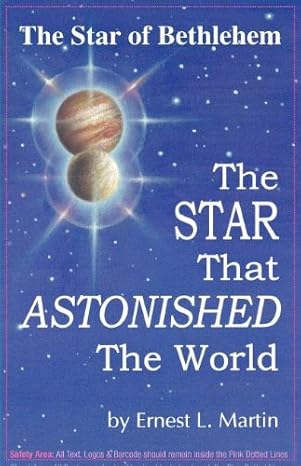The Star That Astonished The World
 ISBN: 978-0945657873
ISBN: 978-0945657873
The Star That Astonished the World was originally written in 1996. Since that time, it is evident that how time is calculated has shifted in some ways since one can see, if they happen to search for dates mentioned in this book, that different years are accorded to events like the lunar eclipse of January 10th. Whereas the book says this is 1 B.C. there are some which now suggest that eclipse happened in 0 instead. Perhaps this is an endorsement of Martin’s theories. Perhaps not. It is hard to know why a given place calculates time as it does even now, which is why what this book is trying to do–understanding the exact birth date of Messiah–is difficult.
The two prongs of the argument that Martin advances concern an inscription found for Quinctilius, the fellow who ordered Qurinius as a Legate to take the census. The argument advanced is that Quinctilius was governor of Syria twice. This would allow Qurinius, if so, to be able to conduct the census in 3 B.C. which would place him as a character administering the census to the pregnant Mary and the accompanying adoptive father, Joseph. The evidence used to promote this claim is historical precedence of the region allowing one to hold offices more than once, when certain wars and actions were taken against the Jewish population and how the historical record might be squared with these moments, and a stone of inscription that might refer to Quinctilius near his home. (it says he was Governor of Syria twice)
A considerable amount of time is spent discussing the death date of Herod as well, which the author identifies as right around January the 10th, 1 B.C. This was when the mentioned lunar eclipse in the source material of Josephus suggests is the point at which Herod dies. Before he dies, Herod, through the Sanhendrin, sentences two Jewish rabbis to death for removing a golden eagle from the gates of the temple. The two rabbis did not do this deed on their own, but had forty youths also assist them. They saw this eagle as being a sacrilege as it was an emblem of Rome over the gates to the temple. Herod has the two rabbis burned to death before he dies on the solar eclipse to try to suggest these two rabbis did not have the favor of YHVH behind them.
When these events are assumed, Martin is then able to deduce certain other historical events that square with the account that make sense of some instructions that were given to take Herod’s effects in Jerusalem by Roman decree after his death. Likewise, it is able to place the deaths of the Jewish believers in the temple which numbered around 3,000 as being in sequence with the “Wars of Varus”. The wars in this case concerned the awards that were given Quinctilius Varus for squashing the Jewish rebellion that occurred at that time. Varus, in this sequence, later loses three legions of Roman soldiers fighting the Germanic people in 9 A.D. This Quinctilius Varus is not the same person as Sulpicius Quirinius but is the one who ordered Quirinius to take the census.
The similarity of the Roman names make this a difficult read at times. All the eclipses and heavenly happenings also make for difficulty in ascertaining timing. Martin does use the many movements of the heavenly bodies of Jupiter and Venus and the Star Regulus to and the many conjunctions they made in the sky as a way to help pin the timing down that the Maji might have followed as well as the birth of the Messiah as a consequence. He notes that by the time the Maji arrived to see the child, many renditions of the account say that the Messiah was all ready able to stand as a toddler would. Therefore, Martin places the birth in around 3 B.C. and has the Maji arriving in 2 B.C. Interestingly, Martin places the birth of the Messiah on September the 11th which he says was the Jewish New year and accords with the Book of Revelation and the final trump or trumpets sounding.
What is evident in reading this work was just how “mixed up” everyone was from about 10 B.C. to 0. Rome is in a party mode and believes it is going to be the leader in a Golden Age of prosperity and enjoys some of its most peaceful moments. A “silver jubilee” is thrown. All the signs Rome sees it interprets as being unique to its destiny. In the mean time, Israel is dealing with Herod and the problems that presents, along with a census being issued by Rome of “all the people in the world”. Dates skip around, and reliable historians like Josephus appear to mix up dates or are inconsistent. Of course, it is also possible they were edited after the fact which make it even harder to understand what was happening at this juncture of time.
Martin makes a good case, however and gets us definitely in the ball park of a plausible timeline. The events that happened then seem to be trying to re-happen now, in a different manner than before. Has the final “Trump” sounded?